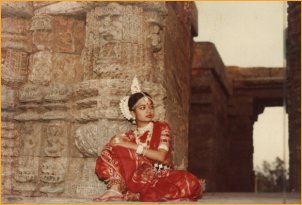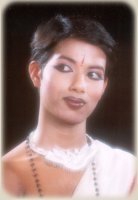
|
 |

|
 |
NEELASHREE PATNAIK Rahul Acharya interviews Neelashree Patnaik, a disciple of Guru Deba Prasad Das e-mail: rahul_acharya@rediffmail.com Dec 2002  Mrs. Neelashree Patnaik, a well-known dancer of yesteryears and one among the chosen few disciples of the legendary Late Deba Prasad Das, showed artistic talents since her childhood. She took minor roles in school recitations and in later years, took prominent roles in dance dramas such as Mahasati Parvati, Bhisma Sara Sajya, Khandaba Dahan and Kartabirjya Sanhar. This was her initial step into the vast field of dance. Shri Sudhakar Sahu, a disciple of Late Deba Prasad Das, initiated her into the nuances of Odissi dance, and then she came under the personal tutelage of the legendary Guru himself. She started her performing career at her hometown, Puri, the cultural capital of Orissa. After completing her M.Sc in Botany (Plant metabolism) from Utkal University and B.Ed, she concentrated on her performing career under the direct guidance of Late Deba Prasad Das and continued it till Guru's sad demise in 1986. She has given remarkable performances at almost all the well-known festivals at Puri and Bhubaneswar and other cities in and outside the state. She has also been trained in Sitar. Presently she is serving as a strict academician, away from the field of dance. How many years did you learn under Late Deba Prasad Das? I learnt under Deba Sir privately for 12 long years, from 1974-1986. What inspired you to get into the field of dance? I had a personal interest in art as such and particularly in dance, since my early childhood. Other dancers also inspired me and my interest was accelerated when I was given lead roles in dance dramas at school and college. Moved by my anxiety to learn the art form, my father decided to make me learn it. Thus I came under the auspices of Shri Sudhakar Sahu, who was then being trained by Deba Sir. It was not too long when I came to be taught by Deba Sir directly. My father-in-law was very encouraging and sincerely wanted me to take up dance as a career, but after marriage I was not able to adjust my time, having dance on one hand, family and academics on the other. Thus I preferred to stop and more so the reason, this change came over after the sad demise of Deba Sir. But I am still in touch with dance, as I choreograph ballets for my students at school. Why did you prefer to learn under Deba Sir? Those were the days when I was staying at Puri with my parents. I wanted to learn under Deba Sir. After much persuasion he agreed to teach me personally at a fees of 100/- (1974). One hundred rupees then was a very big amount and even the most affluent student of Deba Sir gave him not more than 30/- - 40/-. Sir was very punctual and dedicated to his service. I remember one such incident. One day Guruma was severely ill and was hospitalized and the very same day I was to take lessons from Sir and thus I had gone to his house. He did not go to the hospital, instead he taught me that day. Besides I had heard a lot about him and even some dancers told me that he was a perfectionist and a strict disciplinarian. Thus I decided to learn directly under him. Please highlight on his teaching methodology? His style of teaching was unique. Particularly his Sthayee was so well choreographed that I was in love with this item. It is a pure dance number and Sir had filled it with gorgeous postures, taken from exotic dance panels of ancient temples in Orissa. But it was too rigorous and tiring. Sir had infused a lot of folk and traditional culture into his dance which made it very appealing to the common mass. He was a perfectionist. I also loved his Naba Rasa, which has been very well composed. He used to emphasize more on the facial expressions instead of complicating it with unnecessary exhibition of Mudras that made no meaning. Thus his Abhinayas were easily understandable. I remember he had composed an Abhinaya (Dekhile Parana Jiba Chaada Mohana) for me. I was to perform it at Delhi Doordarsan Kendra. This particular item appealed to me the most as it was specially made for me. Deba Sir preferred to tie the saree around instead of cutting it into a stitched costume. I believe his style was the purest and there was not too much show involved. Why did you prefer to stick to him instead of learning from some other Guru? Deba Sir was very famous during that time. His theory knowledge was wonderful. His dance was very pure and was not at all showy. I liked his ways and thus I preferred to stick to him. You have been a well-known dancer in the past. Do you notice any difference in the performance style during your time and the performance style at present? Time has changed. Gone are those days when dance was considered a Sadhana. We did not have many programmes and thus there was no option for us but to practice and polish whatever we had learnt. It was a blessing in disguise as we were moulded into perfect dancers. Nowadays youngsters are more into shows. They are performing immediately after a crash course of 3-4 months. It has become a farce. Those days there were no crash courses offered and we were made to practice hard for minimum 4 years before we stepped onto the stage. Dance has become commercial. Even the Gurus are charging their students per item. It has all become a show. Even the costumes have become too cheap and commercial. No more aesthetic sense is left in people. Given a chance would you like to return to the field of dance? Too many youngsters are there in the field. They should be given a chance to exhibit their talents. Besides, trends have changed. Audience prefer group performances to solo performances. No more are they interested in solo dancers. What is your advice for the dancers of the younger generation? Perfection is very important. Dance is not a child's play. It is a Sadhana. They should not emphasize more on stage performances. They should never try to commercialize and thus dilute this dance form. Always try hard and strive to preserve its pristine purity.  Rahul Acharya, disciple of Guru Durga Charan Ranbir is doing research on Jagannath Culture and the ritualistic aspect of dance under the able guidance of Shri R.N Rathsharma and special guidance from the Gajapati Maharaja of Puri. He is also being trained in the field of Vedas and Shastras, by Shri R.N Rathsharma, who himself is an authority on Jagannath Culture. (December 18, 2002) |